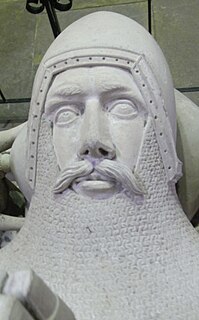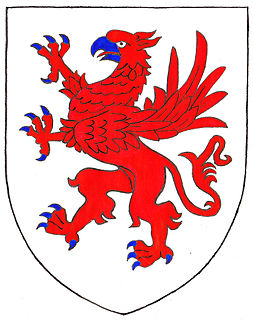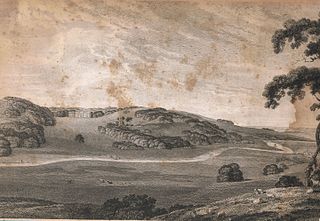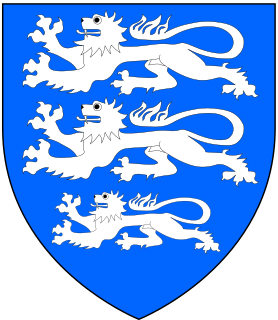
Robert Harington, 3rd Baron Harington (1356-1406) [2] of Gleaston Castle in the manor of Aldingham in Furness, Lancashire, was an English peer.

Robert Harington, 3rd Baron Harington (1356-1406) [2] of Gleaston Castle in the manor of Aldingham in Furness, Lancashire, was an English peer.
He was born at Gleaston Hall in the manor of Aldingham, and was baptised at Aldingham. He was the son and heir of John Harington, 2nd Baron Harington (1328-1363) by his wife, whose name is not known, possibly she was Joan de Birmingham, his step-sister. [2]

His father died in 1363 when Robert was a minor aged 7, and he became a ward of King Edward III, who granted the custody of his paternal lands to his daughter Isabella of England (1332–1382), wife of Enguerrand VII, Lord of Coucy, 1st Earl of Bedford (1340–1397). [2] He exited wardship having attained his majority of 21 and in 1377 was knighted at the coronation of King Richard II (1377-1399). [2] He rebuilt his ancestral seat as a castle, recorded for the first time in 1389 as Gleaston Castle. [2]
He married twice:
He died on 21 May 1406 at Aldingham.

Thomas West, 1st Baron West was an English nobleman and member of parliament.

John Tiptoft, 1st Baron Tiptoft was a Knight of the Shire for Huntingdonshire and Somerset, Speaker of the House of Commons, Treasurer of the Household, Chief Butler of England, Treasurer of the Exchequer and Seneschal of Landes and Aquitaine.
Muchland is a medieval manor in Low Furness in the county of Cumbria in northern England. The manor was the seat of the Lords of Aldingham, and included at its peak the villages of Bardsea, Urswick, Scales, Stainton, Sunbrick, Baycliff, Gleaston, Aldingham, Dendron, Leece and Newbiggin. The area also features the historic remains of Gleaston Castle, Aldingham Castle, Gleaston Water Mill, the Druids' Temple at Birkrigg, plus many prehistoric remains around Urswick and Scales.

Sir Hugh de Courtenay, 2nd/10th Earl of Devon, 2nd Baron Courtenay, feudal baron of Okehampton and feudal baron of Plympton, played an important role in the Hundred Years War in the service of King Edward III. His chief seats were Tiverton Castle and Okehampton Castle in Devon. The ordinal number given to the early Courtenay Earls of Devon depends on whether the earldom is deemed a new creation by the letters patent granted 22 February 1334/5 or whether it is deemed a restitution of the old dignity of the de Redvers family. Authorities differ in their opinions, and thus alternative ordinal numbers exist, given here.

Edmund Stafford was Bishop of Exeter from 1395 to his death in 1419.

Knowstone is a village and civil parish situated in the North Devon district of Devon, England, halfway between the Mid Devon town of Tiverton, Devon and the North Devon town of South Molton. The hamlet of East Knowstone lies due east of the village. Knowstone was the birthplace of Admiral Sir John Berry (1635–1691), second son of Rev. Daniel Berry (1609–1654), vicar of Knowstone cum Molland. An elaborate mural monument erected by Sir John in 1684 to the memory of his parents survives in Molland Church.

James Audley, 2nd Baron Audley of Heighley Castle, Staffordshire, was an English peer. He was the son and heir of Nicholas Audley, 1st Baron Audley (1289–1316) by his wife Joan Martin, who was the daughter of William Martin, feudal baron of Barnstaple, and Marcher Lord of Kemes. She was posthumously the eventual sole heiress of her brother William FitzMartin to Barnstaple and Kemes.

Sir Hugh I Courtenay, of Boconnoc in Cornwall and of Haccombe in Devon, was Sheriff of Devon for 1418/19 and was thrice elected knight of the shire for Devon in 1395, 1397 and 1421. He was a grandson of Hugh de Courtenay, 2nd/10th Earl of Devon (1303–1377), was the younger brother of Edward de Courtenay, 3rd/11th Earl of Devon (1357–1419), "The Blind Earl", and was the grandfather of Edward Courtenay, 1st Earl of Devon (d.1509), KG, created Earl of Devon in 1485 by King Henry VII. He was the link between the senior line of the Courtenay Earls of Devon made extinct following the Battle of Tewkesbury in 1471 and the post-Wars of the Roses creation of a new Earldom for his grandson made in 1485 by King Henry VII.

William de Botreaux (1337–1391) was a prominent British West-Country baron during the reigns of King Edward III (1327-1377) and King Richard II (1377-1399).

Sir Neil Loring, KG, was a medieval English soldier and diplomat and a founding member of the Order of the Garter, established by King Edward III in 1348. The central character in two historical novels by Sir Arthur Conan Doyle, Sir Nigel and The White Company, is loosely based on Neil Loring.

John Harington, 1st Baron Harington (1281–1347) of Aldingham in Furness, Lancashire, was an English peer, created Baron Harington by writ of summons to Parliament dated 1326.

John Harington, 2nd Baron Harington (1328–1363) of Aldingham in Furness, Lancashire, was an English peer, who inherited the title Baron Harington in 1347 on the death of his grandfather John Harington, 1st Baron Harington (1281–1347).

The feudal barony of Bampton was one of eight feudal baronies in Devonshire which existed during the mediaeval era, and had its caput at Bampton Castle within the manor of Bampton.

William Greystoke, 2nd Baron Greystoke, of Greystoke in Cumbria, was an English peer and landowner.

The historic manor of Tawstock was situated in North Devon, in the hundred of Fremington, 2 miles south of Barnstaple, England. According to Pole the feudal baron of Barnstaple Henry de Tracy made Tawstock his seat, apparently having abandoned Barnstaple Castle as the chief residence of the barony. Many of the historic lords of the manor are commemorated by monuments in St Peter's Church, the parish church of Tawstock which in the opinion of Pevsner contains "the best collection in the county apart from those in the cathedral", and in the opinion of Hoskins "contains the finest collection of monuments in Devon and one of the most notable in England".
The Feudal barony of Cardinham is one of the three feudal baronies in Cornwall which existed during the medieval era. Its caput was at Cardinham Castle, Cornwall. The Barony was held in recent times by the Vivian family, the last being Nicholas Vivian, 6th Baron Vivian. Brigadier Nicholas Crespigny Laurence Vivian, 6th Baron Vivian, conveyed the title to John Anthony Vincent of Edifici Maxim's, Carrer General, Arsinal, Principat Andora, in 1995. Mr. Vincent was a member of the Manorial Society of Great Britain and died in Douglas, Isle of Man, on 31 March 2018. The Barony was then conveyed after the probate of his estate to an American citizen on 25 May 2019.

The manor of Wadham in the parish of Knowstone in north Devon and the nearby manors of Chenudestane and Chenuestan are listed in the Domesday Book of 1086:

The title Baron Cobham has been created numerous times in the Peerage of England; often multiple creations have been extant simultaneously, especially in the fourteenth century.

Baron Arcedekne was a peerage created in 1321 for Thomas Arcedekne, 1st Baron Arcedekne (d.1331) of Ruan Lanihorne Castle in Cornwall, Governor of Tintagel Castle in 1312 and Sheriff of Cornwall 1313–14, who was summoned by writ to Parliament in 1321, whereby he became Baron Arcedekne. His descendants were never again summoned to Parliament in respect of the barony, and The Complete Peerage does not list them as holders of that peerage and considers the barony to be abeyant. His descendants were:

Baron Camville was a title created in the Peerage of England for Geoffrey de Camville II, of Clifton Campville in Staffordshire, who having been summoned to Parliament on 24 June 1295 and subsequently, by writs directed to Galfrido de Caunvilla, Caumvilla, Canvilla or Camvilla, was deemed thereby to have been created Baron Camville.